Welfen Laboratory Reports
Durch unsere VerûÑffentlichungsreihe Welfen Laboratory Reports informieren wir û¥ber Forschungsarbeiten an unserem Lehrstuhl, unter anderem werden auf diesem Weg ausgewûÊhlte studentische Abschlussarbeiten publiziert.
Die Welfen Laboratory Reports erscheinen hauptsûÊchlich online, auf Anfrage geben wir gerne auch gedruckte Exemplare zum Selbstkostenpreis heraus.
Welfen Laboratory Report No. 7
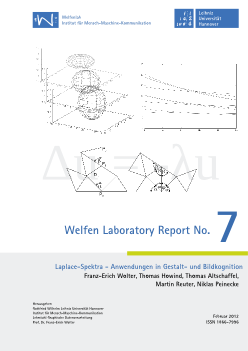 Laplace-Spektra - Anwendungen in Gestalt- und Bildkognition
Laplace-Spektra - Anwendungen in Gestalt- und Bildkognition
Franz-Erich Wolter, Thomas Howind, Thomas Altschaffel, Martin Reuter, Niklas Peinecke. Januar 2012.
Welfen Laboratory Report No. 6
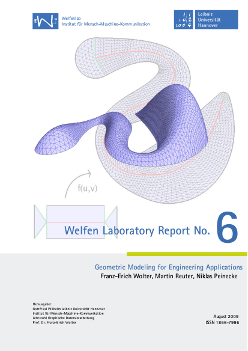 Geometric Modelling for Engineering Applications.
Geometric Modelling for Engineering Applications.
Franz-Erich Wolter, Martin Reuter, Niklas Peinecke. August 2009.
This report was also published as
Franz-Erich Wolter, Martin Reuter, Niklas Peinecke: "Geometric Modeling for Engineering Applications" in Encyclopedia of Computational Mechanics. Part 1: Fundamentals. E. Stein, R. de Borst & T.J.R. Hughes (eds.), John Wiley & Sons, 2007.
Abstract
A geometric model of an object - in most cases being a subset of the three dimensional space - can be used to better understand the object's structure or behavior.
Therefore data such as the geometry, the topology and other application specific data have to be represented by the model. With the help of a computer it is possible to manipulate, process or display these data.
We will discuss different approaches for representing such an object: Volume based representations describe the object in a direct way, whereas boundary representations describe the object indirectly by specifying its boundary. A variety of different surface patches can be used to model the object's boundary. For many applications it is sufficient to know only the boundary of an object.
For special objects explicit or implicit mathematical representations can easily be given. An explicit representation is a map from a known parameter space for instance the unit cube to 3D-space. Implicit representations are equations or relations such as the set of zeros of a functional with three unknowns. These can be very efficient in special cases.
As an example of volume based representations we will give a brief overview of the voxel representation. We also show how the boundary of complex objects can be assembled by simpler parts such as surface patches. These come in a variety of forms: planar polygons, parametric surfaces defined by a map from 2D-space to 3D-space, especially spline surfaces and trimmed surfaces, multiresolutionally represented surfaces (for example wavelet-based) and surfaces obtained by subdivision schemes.
In a boundary representation only the boundary of a solid is described. This is usually done by describing the boundary as a collection of surface patches attached to each other at outer edges. One of the (topologically) most complete schemes is the half-edge data structure as described by MûÊntylûÊ.
Simple objects constructed via any of the methods above can be joined to build more complex objects via Boolean operators (constructive solid geometry, CSG). Constructing an object one has to assure that the object is in agreement with the topological requirements of the modeling system. Notoriously difficult problems are caused by the fact that most modeling systems can compute surface intersections only with a limited precision. This yields numerical results that may finally cause major errors such as topologically contradictory conclusions.
The rather new method of "Medial Modeling" is also presented. Here an object is described by its medial axis and an associated radius function. The medial axis itself is a collection of lower dimensional objects, i.e. for a 3D-solid a set of points, curves and surface patches. This medial modeling concept developed at the Welfenlab yields a very intuitive user interface useful for solid modeling, and also gives as a by-product a natural meshing of the solid for FEM computations.
Additional attributes can be attached to an object, like attributes of physical origin or logical attributes. Physical attributes include photometric, haptical and other material properties, such as elasticity or roughness. Physical attributes are often specified by textures. These texture are mapped to the surface to relate surface points to certain quantities of the attribute. The most common use for these are photometric textures, although they can also be used for roughness etc. Logical attributes relate the object to its (data-)environment. They can for example group objects which are somehow related, or they can associate scripts to the object,such as callbacks for user interactions.
Welfen Laboratory Report No. 5
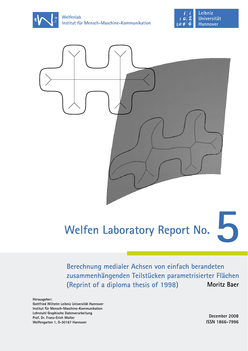 Berechnung medialer Achsen von einfach berandeten zusammenhûÊngenden Teilstû¥cken parametrisierter FlûÊchen
Berechnung medialer Achsen von einfach berandeten zusammenhûÊngenden Teilstû¥cken parametrisierter FlûÊchen
Moritz Baer, December 2008.
This report, being a reprint of a diploma thesis written at the Welfenlab in 1998, describes an algorithm for the precise computation of geodesic medial axes on bordered parametric surfaces. The report is focusing on the case where the medial axes are computed for simply connected bordered subsurfaces whose boundaries are defined by piecewise regularly parameterized surface curves.
The algorithm is essentially based on tracing a differential equation for locally medial curves. Several important properties of the medial axis are finally used to select only those locally medial curves for the computation of the medial axis that effectively belong to the medial axis.
These research results in this thesis were innovative at the time when the thesis was written and they remain being up to date even 10 years later until today in 2008.
Welfen Laboratory Report No. 4
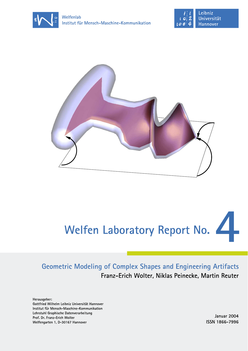 Geometric Modeling of Complex Shapes and Engineering Artifacts
Geometric Modeling of Complex Shapes and Engineering Artifacts
Franz-Erich Wolter, Niklas Peinecke, Martin Reuter; January 2004
A geometric model of an object -- in most cases being a subset of the three dimensional space -- can be used to better understand the object's structure or behaviour. Therefore data such as the geometry, the topology and other application specific data have to be represented by the model. With the help of a computer it is possible to manipulate, process or display these data.
We will discuss different approaches for representing such an object:
Volume based representations describe the object in a direct way, whereas boundary representations describe the object indirectly by specifying its boundary. A variety of different surface patches can be used to model the object's boundary. For many applications it is sufficient to know only the boundary of an object.
For special objects explicit or implicit mathematical representations can easily be given. An explicit representation is a map from a known parameter space e.g. the unit cube to 3D-space. Implicit representations are equations or relations such as the set of zeros of a functional with three unknowns. These can be very efficient in special cases.
As an example of volume based representations we will give a brief overview of the voxel representation. We also show how the boundary of complex objects can be assembled by simpler parts e.g. surface patches.
These come in a variety of forms: planar polygons, parametric surfaces, especially spline surfaces and trimmed surfaces, multiresolutionally represented surfaces, e.g. wavelet-based surfaces.
In a boundary representation only the boundary of a solid is described. This is usually done by describing the boundary as a collection of surface patches attached to each other at outer edges.
Simple objects constructed via any of the methods above can be joined to build more complex objects via Boolean operators (constructive solid geometry, CSG). Constructing an object one has to assure that the object is in agreement with the topological requirements of the modeling system. Notoriously difficult problems are caused by the fact that most modeling systems can compute surface intersections only with a limited precision. This yields numerical results that may finally cause major errors e.g. topologically contradictory conclusions.
The rather new method of "Medial Modeling" is also presented. Here an object is described by its medial axis and an associated radius function. The medial axis itself is a collection of lower dimensional objects, i.e. for a 3D-solid a set of points, curves and surface patches. This medial modeling concept developed at the Welfenlab yields a very intuitive user interface useful for solid modeling, and also gives a natural meshing of the solid for FEM computations.
Additional attributes can be attached to an object, i.e. attributes of physical origin or logical attributes. Physical attributes include photometric, haptical and other material properties, such as elasticity or roughness. Physical attributes are often specified by textures, i.e. functions that relate surface points to certain quantities of the attribute. The most common use for these are photometric textures, although they can also be used for roughness etc. Logical attributes relate the object to its (data-)environment. They can e.g. group objects which are somehow related, or they can associate scripts to the object.
Welfen Laboratory Report No. 3
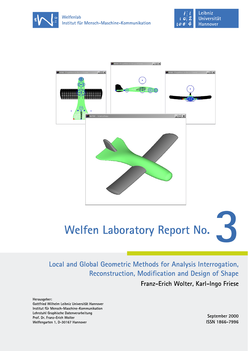 Local and Global Geometric Methods for Analysis Interrogation, Reconstruction, Modification and Design of Shape
Local and Global Geometric Methods for Analysis Interrogation, Reconstruction, Modification and Design of Shape
Franz-Erich Wolter, Ingo Friese; September 2000
This paper gives an overview of some recent methods useful for local and global shape analysis and for the design of solids. These methods include as new tools for global and local shape analysis the Spectra of the Laplace and the Laplace-Beltrami Operator and the Concept of stable Umbilical Points i.e. stable singularities of the principal curvature line wire frame model of the solid's boundary surface. Most material in this paper deals with the Medial Axis Transform as a tool for shape interrogation, reconstruction, modification and design. We show that it appears to be possible to construct an intuitive user interface that allows to mould shape employing the Medial Axis Transform. We also explain that the Medial Axis and Voronoi Diagrams can be defined and computed as well on free form surfaces in a setting where the geodesic distance between two points p, q on a surface S is defined by the shortest surface path on S joining the two points p, q. This leads to the natural and computable generalized concepts of geodesic Medial Axis and geodesic Voronoi Diagram on free form surfaces. Both can be computed with a reasonable speed and with a high accuracy (of about 12 digits when double floating point arithmetic is used for the computations).
Welfen Laboratory Report No. 2
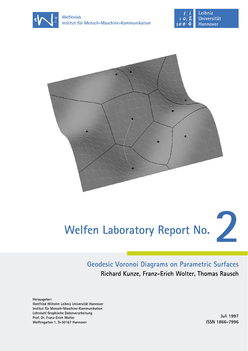 Geodesic Voronoi Diagrams on Parametric Surfaces
Geodesic Voronoi Diagrams on Parametric Surfaces
Richard Kunze, Franz--Erich Wolter, Thomas Rausch; July 1997
In this paper we will extend the concept of Voronoi diagrams to parameterized surfaces where distance between two points is defined as infimum over the lengths of surface paths connecting these points. We will present a method to compute Voronoi diagrams on these surfaces.
Welfen Laboratory Report No. 1
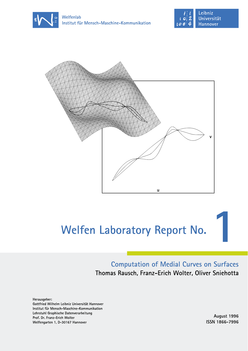 Computation of Medial Curves on Surfaces
Computation of Medial Curves on Surfaces
Thomas Rausch, Franz-Erich Wolter, Oliver Sniehotta; August 1996
Medial curves considered in this paper may be regarded roughly spoken as the local equidistantial set of certain subarcs of two given border curves. In contrast to the problem of computing the equidistantial set (which is a global problem) we focus our attention on the related local problem by ignoring the question whether the computed curve consists only of points that are truly equidistantial to both border curves, the latter ones considered in their full range. In this paper a method for tracing the medial curve of two border curves is presented. This method is based on the numerical solution of a system of differential equations in the parameter space of the considered surface. It is proven that this system remains regular as long as the medial curve stays away from focal points of the border curves. Finally, it is indicated how the concept might be extended in order to trace the focal curve of a given curve on the surface. The techniques here are designed to work on arbitrary regular surfaces where distance has to be understood as geodesic distance. The method however is useful in the planar case too.
Herausgeber
Gottfried Wilhelm Leibniz UniversitûÊt Hannover
Institut fû¥r Mensch-Maschine-Kommunikation
Lehrstuhl Graphische Datenverarbeitung
Prof. Dr. Franz-Erich Wolter
Welfengarten 1, D-30167 Hannover
ISSN 1866-7996 (online)

